‘The Women’ 1939
In 1939, Metro-Goldwyn-Mayer released a film adaptation of the Broadway hit play ‘The Women’ by Clare Boothe[1903-1987] which contains extended sequences inside a beauty salon. Directed by George Cukor [1899-1983] from a script written by Anita Loos [1888-1981] and Jane Murfin [1884-1955], it contained an all-female cast which included Norma Shearer [1902-1983], Joan Crawford [c.1904-1977], Rosalind Russell [1907-1976], Mary Boland [1882-1965], Paulette Goddard [1910-1990] and Joan Fontaine [1917-2013].
Treatments
The movie opens outside Sydney’s beauty salon on Park Avenue, New York – the name pays homage to Sydney Guilaroff [1907-1997], the chief hairstylist at MGM at the time. According to Woodhead the set design took its inspiration from the Fifth Avenue salon of Elizabeth Arden [1881-1966] (Woodhead, 2003, p. 250). Apparently, Arden saw the salon set when her ex-employee Hedda Hopper [1885-1966] – who appeared in the film as the society columnist Dolly Dupuyster – took Elizabeth to the studio to see it. Arden was apparently unhappy about it, perhaps because many details seem to have been taken from the new Fifth Avenue salon of Helena Rubinstein [1872-1965] which opened in 1936.
See also: Rubinstein Day of Beauty
The movie opens by following Mrs. Van Adams from just outside Sydney’s salon into the reception where she is booked in. We then pass to an upstairs waiting room where a Mrs. Spencer and Mrs. Carter enter and begin looking at a display of miniatures – a possible reference to Helena Rubinstein’s collection of miniature rooms on display in her New York salon – which Mrs. Carter describes as a “sure sign of a petty mind”. The two women are then ushered into an examination room where Mrs. Spencer has her face viewed under a dermascope.
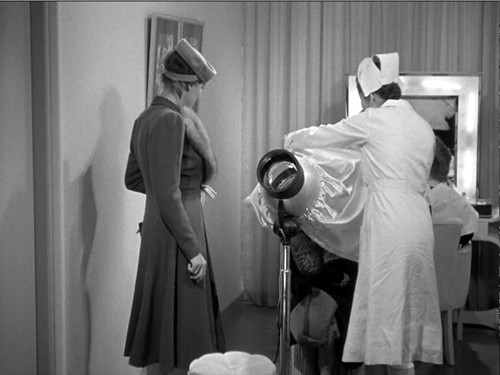
Above: Dermascope examination.
Mrs. Carter pushes the attendant to one side, looks down the dermascope herself and exclaims “I hate to tell you, dear, but your skin makes the Rockies look like chiffon velvet.”

Above: View through the dermascope, an instrument similar to the Derma-Lens promoted by Helena Rubinstein. Mrs. Spencer appears to be wearing false eyelashes.
See also: Complexion Analysers (Dermoscopes)
We then track the women through a series of rooms where we see:
1. A client attached to a machine for measuring basal metabolic rate.

Above: Measuring basal metabolic rate by calculating oxygen consumption while resting. This was a common measurement used by an in-house doctor to help determine a client’s diet plan.
2. A tiled room with clients taking foam and mud baths.
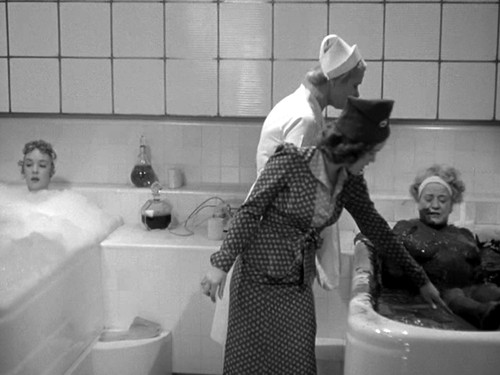
Above: Foam bath (left) and mud bath (right). Both foam baths and mud baths were used in slimming programs with mud baths also used in curative treatments such as relieving the symptoms of rheumatism. A woman wearing a mud pack on her face used in one of the trailers for the film was deleted from the final cut.
3. A booth where a client is receiving a body massage.

Above: Body massage treatment. These were used for general relaxation but particular massage movements were also used in slimming or contouring treatments.
4. A larger room with clients relaxing under sun lamps.
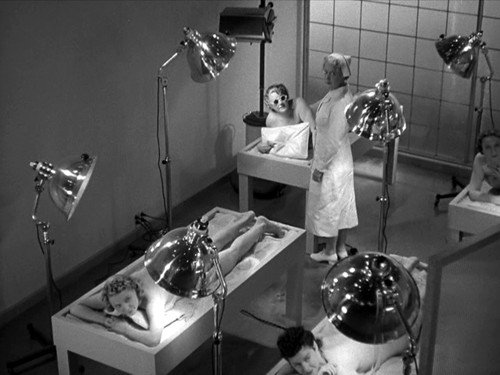
Above: Solarium. A nurse is also seen giving one client a body massage. The women are lying on beach sand, a feature of Helena Rubinstein’s ’Sun Clinic’ available in her New York salon.
At the start of this sequence an older woman – who is the subject of a lot of comments as she is going to marry a jockey – disappears up a spiral staircase wearing only a towel. She is heading for a steam bath or infra-red treatment, edited out of the final cut of the film but depicted in a 1939 article in LIFE magazine.
5. A gymnasium with clients exercising on horizontal bars.
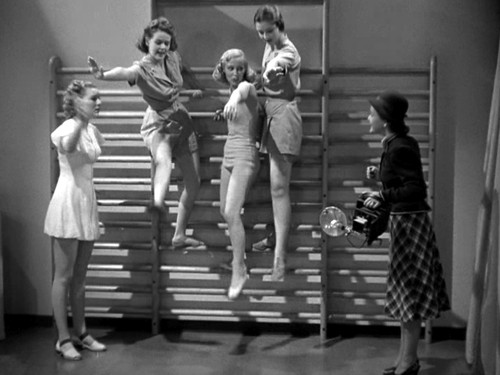
Above: Women exercising on gymnasium bars led by an instructor. Rooms like this with a gymnasium bar, mirror and gym mat on the floor were very common in salons that provided calisthenic treatments. A second sequence, later the movie, features Peggy Day (Joan Fontaine) and Sylvia Fowler (Rosalind Russell) going through a series of exercises against the wall and on a gym mat. Sylvia ends the scene by going off to have a paraffin wax bath which unfortunately is not shown.
See also: Paraffin Wax Treatments
6. A room with bicycles and a rowing machine.

Above: Exercise bicycles and rowing machines were used to build up strength and fitness and to help maintain or lose weight.
7. A cubicle where a diathermy treatment is being conducted.
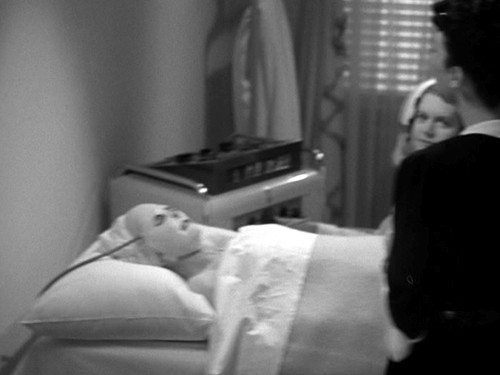
Above: Diathermy treatment with nurse in attendance, possibly based on Elizabeth Arden’s Vienna Youth Mask.
See also: Arden Vienna Youth Mask
8. A facial booth where a client is having a face mask applied during a facial treatment.

Above: Facial treatment which includes a face mask.
9. A room where an attendant is using hot wax to remove superfluous hair from the forearm of a client.
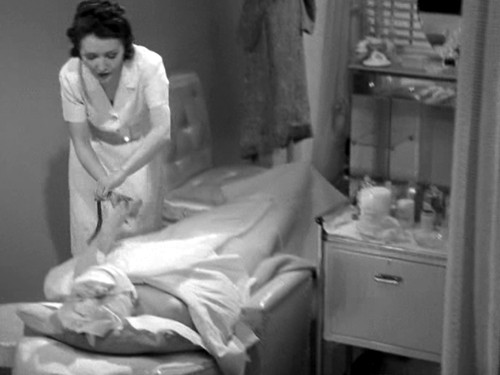
Above: Hot wax treatment to remove hair from the forearm.
Soon after this we move to the hairdressing salon where Mrs. Sylvia Howard Fowler (Rosalind Russell) is receiving a manicure from Olga (Dennie Moore [1902-1978]).
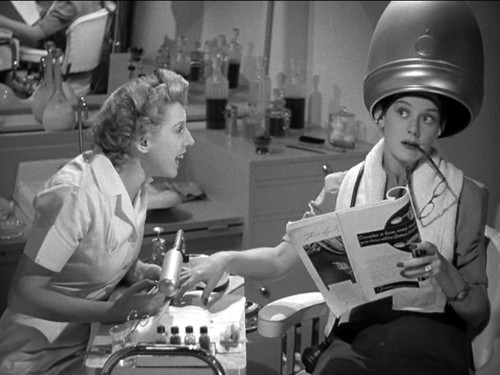
Above: Sylvia finds out from Olga that Stephen Haines is having an affair with Crystal Allen. The nail polish looks to be from Glazo.
See also: Glazo
Sylvia is getting a manicure while her hair dries and will soon learn from the manicurist that the husband of Mary Haines (Norma Shearer) is having an affair with perfume counter salesgirl Crystal Allen (Joan Crawford), the event that propelled the plot for the rest of the movie.
First Posted: 6th April 2015
Last Update: 8th April 2024
Sources
Movie of the week: The women. (1939). LIFE, September 4, 28-29.
Stromberg, H. (Producer), & Cukor, G. (Director). (1939). The women [Motion picture]. United States: Metro-Goldwyn-Mayer.
Woodhead, L. (2003). War paint: Miss Elizabeth Arden and Madame Helena Rubinstein. Their lives, their times, their rivalry. London: Virago.
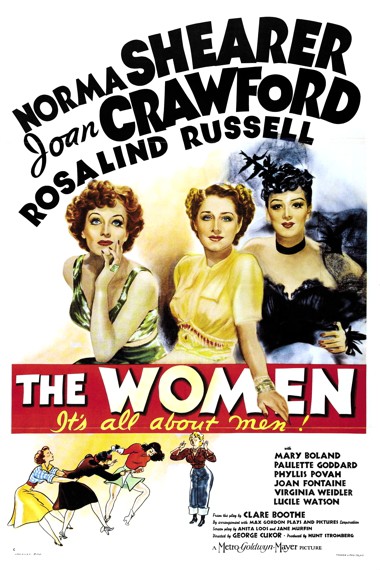
1939 ‘The Women’ movie poster.
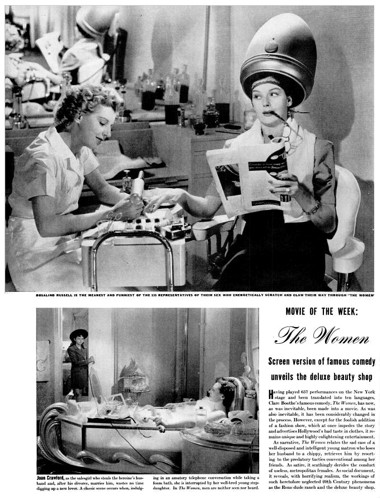
1939 First page of a LIFE magazine article on ‘The Women’.
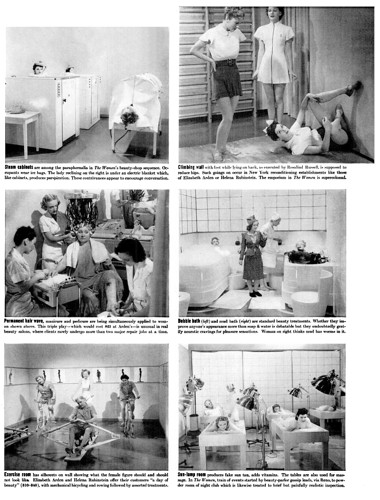
1939 Second page of a LIFE magazine article on ‘The Women’.
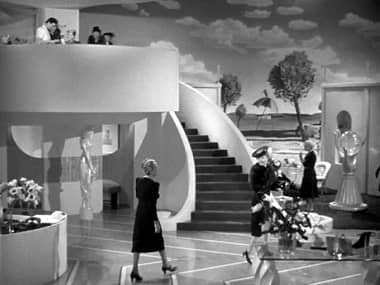
1939 Lobby of Sydney’s salon from ‘The Women’.
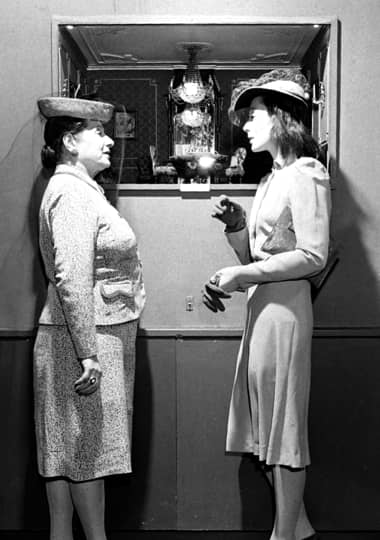
1941 Helena Rubinstein and an unknown woman looking at miniature rooms in Helena Rubinstein’s salon on Fifth Avenue, New York.
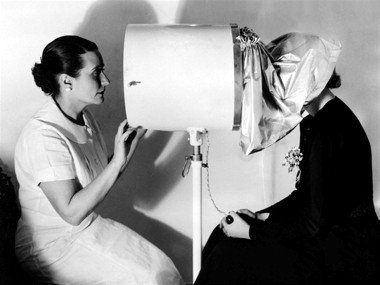
1937 Derma-Lens used in Helena Rubinstein salons to magnify skin defects.
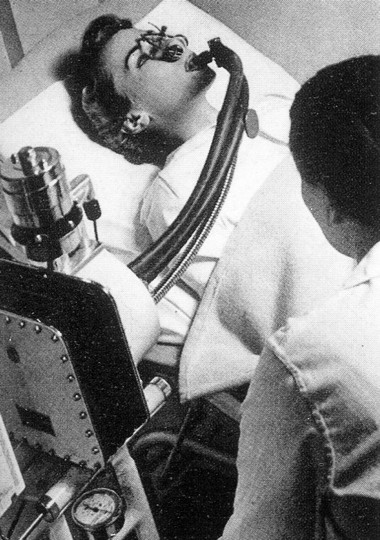
A client having her metabolic rate measured by a nurse in an Helena Rubinstein salon.
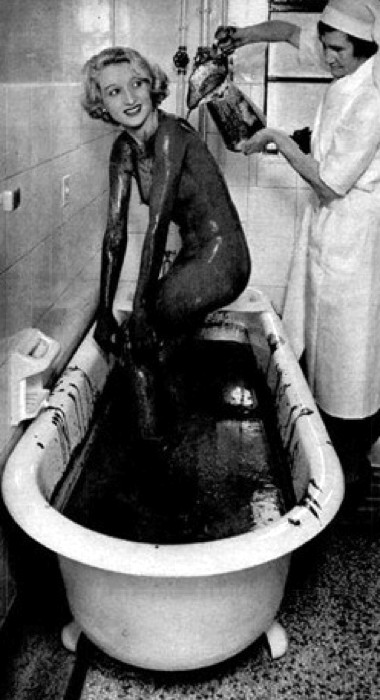
1937 Woman taking a mud bath.
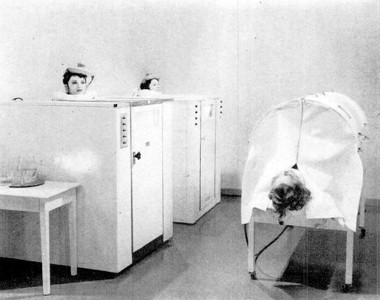
1939 Steam treatment (left) for weight reduction, deleted from the final cut of ‘The Women’. The other treatment (right) looks like an infra-red heat bath also used in a weight-reduction plan. It may be modelled on Helena Rubinstein’s San-O-Therm treatment she introduced in 1937.
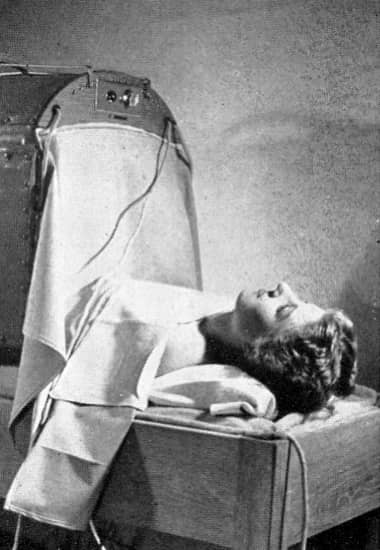
1937 Helena Rubinstein’s San-O-Therm treatment.
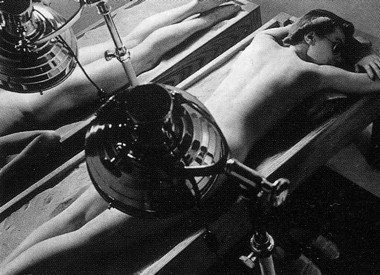
1937 Sun lamps used in Helena Rubinstein’s New York salon. The clients are lying on beds of beach sand. The treatments used a combination of infra-red and UV light.
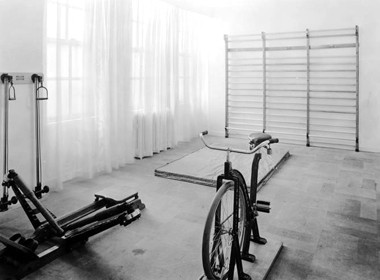
1936 Exercise room at Helena Rubinstein’s salon on Fifth Avenue, New York with gymnasium bar, gym mat, fitness bicycle and rowing machine.
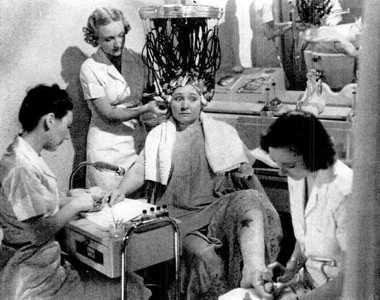
1939 Triple treatment of permanent wave, manicure and pedicure, also not included in the final cut of ‘The Women’. This would have been comical but not realistic.
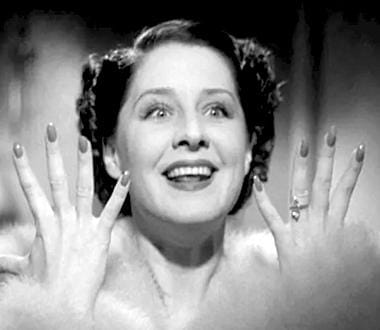
Mary Haines (Norma Shearer) wearing Jungle Red nail polish. Glazo had introduced Tropic, and Congo shades in 1937 but not Jungle Red. The practice of applying cream nail polish over the entire nail plate was relatively new in the 1930s and women in the audience would have taken notice.
